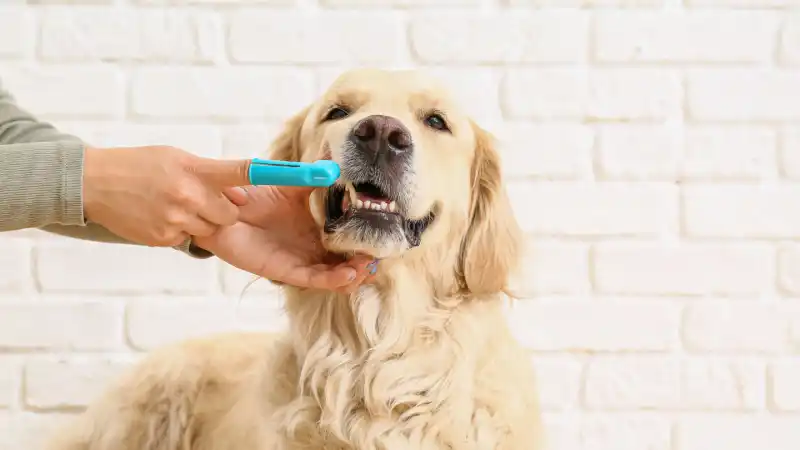Natural Flea and Tick Prevention for Dogs
Learn about natural flea and tick prevention for dogs, including home remedies and repellants. Find DIY flea and tick treatments to keep them itch-free.

For most pet owners, the first line of defense against fleas and ticks is preventive medication. Your veterinarian will be able to recommend the best product based on your dog, your environment, and your budget. AKC Pet Insurance (underwritten by Independence American Insurance Company) wellness coverage offers reimbursement towards flea/tick preventives to help keep your costs down, while ensuring your dog stays healthy! If you’re looking for extra protection for your pooch or want to learn more about natural methods of flea and tick prevention – read on!
A Quick Overview
Fleas thrive in warm, humid weather and can lay up to 50 eggs a day. A single flea can become 1,000 fleas in your home in only 21 days! With a life cycle anywhere between 14 days and 12 months, fleas can become a serious problem for your pet and your home. The average flea is between two and three millimeters long and weighs about 0.03 grams, so preventing fleas from infesting your pet can be quite a challenge.
Since ticks love warm weather, the summer and fall are peak tick seasons for most of the United States. Ticks are known to spread diseases, but did you know that they can spread multiple diseases with one bite? For this reason, it’s important to learn about ticks and how you can prevent them from pestering your pup.
Natural Ways to Get Rid of Fleas and Ticks
Fleas and ticks usually end up on your dog while they are outside your home, so creating a yard that is dog-friendly, but not favorable for pests, is crucial.
Treat the Yard
There are plenty of natural products that use essential oils and other non-toxic ingredients that can be sprayed on your yard to prevent pests from breeding near your home.
Create a Barrier
Remove leaf litter and plantings within 6-18 inches of your house.
Mow the Lawn
You shouldn’t let your grass grow too high, as fleas and ticks prefer to breed in tall grass. However, refrain from mowing your lawn too short, since this repels ants and spiders – the fleas’ natural enemies.
Apply Cedar Mulch
Fleas hate cedar, so using cedar mulch in your gardens and around your home acts as a natural barrier.
Trim Limbs and Shrubs
Fleas and ticks prefer dark, damp areas, so remove dead limbs and prune thick shrubs to allow sunlight to permeate your yard.
Inside Your Home
Once fleas have gotten into your home, it's hard to get rid of them!
DIY Traps
Fill a wide, shallow pan with soapy water and place it on the floor in the area that you believe is highly populated with fleas. Shine a lamp directly over the water. Fleas are drawn to the heat of the lamp and will jump into the light, only to land in the soapy water. The soap in the water prevents the flea from jumping out, causing them to die.
Diatomaceous Earth
Food-grade diatomaceous earth can be applied to your pet’s environment to quickly kill fleas. Diatomaceous earth is sharp and will cut holes in the flea’s body. It is also extremely absorbent and will dehydrate the flea, causing them to die. When used inside your home around windows, doors, baseboards, dog beds, or carpets, you should vacuum treated areas after a few hours to remove any dead fleas. You can then re-apply the diatomaceous earth to kill the remaining fleas.
While food-grade diatomaceous earth is safe for use around your pets, you should be careful when sprinkling it so that your pet doesn’t inhale the earth or try to ingest it. Check with your veterinarian before applying the earth directly to your pet’s coat. Diatomaceous earth can dry out skin and cause it to become irritated.

Every Dog and Cat Deserves the Pet Insurance of Champions
Get prize-winning care for your pets.
DIY Shampoos & Sprays
Vinegar
Combine 1 quart of water, 1 cup of white vinegar or apple cider vinegar, and 1 cup of baby shampoo or liquid dish soap. Use this mixture to bathe your dog once or twice a month. Vinegar kills fleas and ticks on contact and can prevent future infestations.
Lemon Wash Deterrent
Lemon juice repels fleas and can be used in several ways to keep them off of your pet. For this mixture, you will need 4 slices of fresh lemon, 1 tablespoon of salt, and 6 cups of water. Heat the water until boiling, then add the salt and fresh lemon. Boil for two minutes and then remove from the heat. Let the mixture steep for a full day (24 hours), then apply to your dog’s fur after shampooing and washing them. This mixture can be applied daily.
For more information on homemade shampoos, please see this article from the American Kennel Club.
Essential Oils for Fleas and Ticks
Essential oils are the concentrated versions of natural oils in plants that are distilled or cold pressed and then bottled in high concentrations. While some essential oils are toxic to dogs and/or cats, there are some that have proven to be beneficial to repelling pests. Diluted essential oils can be used to create spray-on repellants, added to your dog’s shampoo, or brushed into your dog’s coat.
It’s important to speak with your veterinarian before using essential oils in your home or on your pets to determine safe plants, brands, and concentrations. If you have a cat in your home, ensure that any oils you use on your dog aren’t toxic to cats. Essential oils should also never be ingested by your pet, never be applied directly in a concentrated form, and should not be used on pregnant animals unless directed by a veterinarian.
Lavender– The aroma is known to keep both fleas and ticks away, in addition to preventing tick eggs from hatching. Adding 5-10 drops to your dog’s shampoo can help to soothe irritated skin and prevent infection.
Lemongrass– The active ingredients citral and geraniol are natural flea repellants. Adding five drops of lemongrass oil to a spray bottle, and filling the rest of the bottle with water, can produce a spray for use on your pup, carpet, or furniture.
Peppermint– By applying peppermint oil to the area of your dog that has been affected by fleas, this essential oil can relieve skin irritation and inflammation. It is also useful for killing flea larvae in your home and on your pet.
Rosemary– Rosemary oil acts as a flea repellant and can help heal flea bites. Add 5-8 drops to your dog’s shampoo to keep fleas off of them.
Cedar– Fleas and ticks are deterred by cedar, so adding a few drops to a carrier oil or your dog’s shampoo can help to keep them off your pup.
Citronella– Great for discouraging mosquitoes, fleas, and ticks, citronella oil can be placed in a spray bottle and used on your pet, yard, or inside your home. You should fill a spray bottle with water, add 15 drops of oil, and shake before each use.
Eucalyptus Oil– Fleas dislike the strong eucalyptus smell, so adding it into your bath time routine can help greatly in keeping your pup flea-free. Add three drops of oil per tablespoon of dog shampoo, apply to your dog’s coat, then wash the shampoo out thoroughly.
Regular Prevention Is Key
Using a natural method of prevention can help to reduce the population of fleas and ticks in your home and yard, without causing a negative impact on the environment. With these added measures to keep your dog free of annoying pests, the two of you can spend more time enjoying the outdoors!

Every Dog and Cat Deserves the Pet Insurance of Champions
Get prize-winning care for your pets.

Mary comes to AKC Pet Insurance with an extensive background in animal care. As a lifelong animal lover, she has a passion for promoting pet health and wellness. Mary lives in Kentucky with her orange kitty, "Cat" and her dog, " Wubbi".
READ MORE ARTICLES

